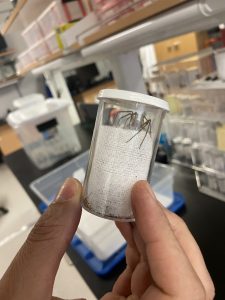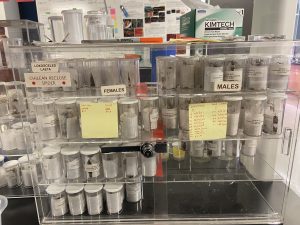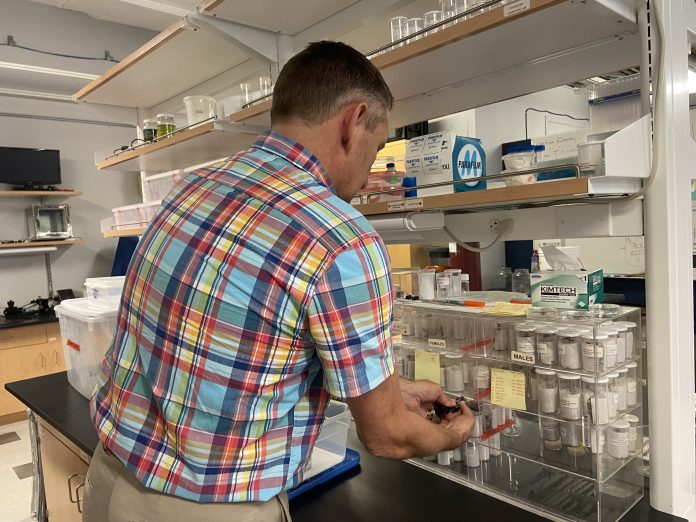Spiders are not often welcome visitors, particularly ones with a venomous bite, like brown recluse spiders. But according to researchers at the College of William and Mary, brown recluse spiders produce something that could be the future of engineering — silk.
Virginia Microelectronics Consortium Professor of Applied Science Hannes C. Schniepp is the Principal Investigator of the Nano and Biomaterials Lab at the College, which spearheaded the research. Together, the team recently published three groundbreaking papers in high-impact academic journals — “Materials Horizons,” “Small” and “Nature Communications” — describing their findings on the structure of recluse spider silk and its potential applications.
Spider silk is known to be stronger than steel and tougher than Kevlar (the material used in bulletproof vests), which means it can be stretched and absorb large amounts of energy without breaking. Its other beneficial properties include its durability, extendability, and ability to be exposed to extreme temperatures. As an engineering material, these qualities are ideal.
“The bigger picture is that in our research group, we have been working on silks and especially spider silk for about ten years, for a little over ten years now,” Schniepp said. “And it’s been really an exciting journey. I think spider silk, the material that we know all from spider webs, is actually like some super cool high tech stuff. It may not seem like much when you walk out there and you get caught in a spider web. But this is actually super cool stuff.”

Not all spider silks are built the same, however.
“So people are wondering how spiders got all of those amazing properties,” Materials Science Ph.D Candidate Dinidu Perera said. “And to find that out, we need to study the natural material, and that is what we do in our lab. In this particular project, we studied the structure and the mechanical properties of recluse silk. So basically we found that the recluse silk is just like Scotch tape.”
Recluse silk is less cylindrical than other spider silks and is instead made of many nano fibers running parallel to each other. The team studied how these fibers bond to each other.
Spider silk also has one attribute that many other building materials don’t — it’s environmentally friendly. Spider silk is made of protein, a natural material that could be consumed by humans without being rejected by our bodies. While Schniepp isn’t advocating spider silk as the next snacking trend, it could be used for other things that enter the human body, like medical instruments. Spiders don’t produce enough silk to replace plastics or metals, but if scientists know how spider silks are constructed, they can better reproduce them synthetically.
“Over the years, we went just deeper and deeper into this,” Schniepp said. “Because the big vision out there — of course, by just sitting in our lab and studying spiders and their silk, we’re not we’re not solving any problems. Right? So eventually we want to mass produce materials like this.”
The team sought to zoom in as close as possible on spider silks to understand their structure. What makes this most recent contribution to the field important is that the scientists were able to see individual protein molecules in great detail, combining a series of different experimental tools to learn more about the material.
“In this project, we developed a new method to measure these types of materials,” Perera said. “Actually the new technique or the new method we developed here can also be applied to measure the properties of other materials. For example, it can be further developed as a disease diagnostic method.”

Perera explained that the mechanical properties of cancer cells, for example, are different from the mechanical properties of healthy cells.
“Actually, we can use the method we developed here to measure those mechanical properties at the cellular scale,” Perera said. “By doing that, we can identify the cancer cells and the healthy cells by measuring the mechanical properties of these cells at the microscale. So our method has the potential to be developed as an advanced disease diagnostic method.”
Ben Skopic ’19, a current Ph.D Candidate in Materials Science at the College, has been working on the project with Professor Schniepp in his lab since 2017. He is now working on a dissertation on the adhesive properties of recluse spider silk. According to Skopic, this is the kind of project that requires multiple disciplines to be successful. While Schniepp works in applied science, the research in the Schniepp lab was also led in part by physics professor Mumtaz Qazilbash and professor Myriam Cotten, who works on biophysical chemistry and structural biology.
“I really like how our spider silk research is very interdisciplinary, where I work mostly with physics, although there’s a large biological component, obviously with the spiders, and also a chemical component as well,” Skopic said. “And so I wanted to branch out all of that beyond just physics. And so I got involved about my sophomore year of my undergrad and really enjoyed doing research and wanted to stay on to continue asking good questions and being able to answer them in the lab.”
Perera also joined the lab in 2017 after taking a class on nano and microscale materials. Using an atomic force microscope, students in the class could observe structures that are 10,000 times smaller than the size of a human hair. That is the same instrument the scientists in the Nano and Biomaterials Lab used to analyze spider silk for this project.
When the first paper got published, Perera said it was an exciting moment, especially after nearly six years of tough research.
“It was the most exciting moment I had, because it was like a kind of dream for us to publish a paper in such a good journal,” Perera said. “I was amazed and so excited when we first got the email from the journal that our paper got accepted.”
Much of the research for the three papers was also supported by undergraduates at the College, and Skopic emphasized their important role in the process — from conducting experiments to taking care of the lab’s recluse spiders.
“We do currently also have like six or seven undergrads working in the lab and we’re always welcome to have more,” Skopic said. “And I know particularly my project right now, actually, I could probably use an undergrad to help. So we’re always looking for more help in the lab and to get more people involved in the research.”


[…] silks because, for their size, it is much stronger than any material that humans can make. In fact, spider silk is known to be stronger than steel and even Kevlar — the material used in bulletproof vests. So, it can absorb large amounts of force before it […]